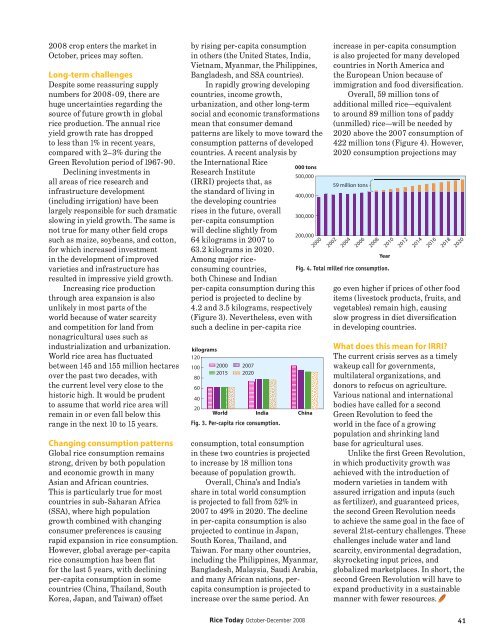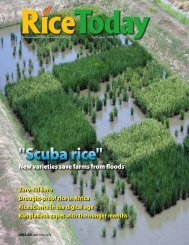Rice Today - adron.sr
Rice Today - adron.sr
Rice Today - adron.sr
Create successful ePaper yourself
Turn your PDF publications into a flip-book with our unique Google optimized e-Paper software.
2008 crop enters the market inOctober, prices may soften.Long-term challengesDespite some reassuring supplynumbers for 2008-09, there arehuge uncertainties regarding thesource of future growth in globalrice production. The annual riceyield growth rate has droppedto less than 1% in recent years,compared with 2–3% during theGreen Revolution period of 1967-90.Declining investments inall areas of rice research andinfrastructure development(including irrigation) have beenlargely responsible for such dramaticslowing in yield growth. The same isnot true for many other field cropssuch as maize, soybeans, and cotton,for which increased investmentin the development of improvedvarieties and infrastructure ha<strong>sr</strong>esulted in impressive yield growth.Increasing rice productionthrough area expansion is alsounlikely in most parts of theworld because of water scarcityand competition for land fromnonagricultural uses such asindustrialization and urbanization.World rice area has fluctuatedbetween 145 and 155 million hectaresover the past two decades, withthe current level very close to thehistoric high. It would be prudentto assume that world rice area willremain in or even fall below thi<strong>sr</strong>ange in the next 10 to 15 years.Changing consumption patternsGlobal rice consumption remainsstrong, driven by both populationand economic growth in manyAsian and African countries.This is particularly true for mostcountries in sub-Saharan Africa(SSA), where high populationgrowth combined with changingconsumer preferences is causingrapid expansion in rice consumption.However, global average per-capitarice consumption has been flatfor the last 5 years, with decliningper-capita consumption in somecountries (China, Thailand, SouthKorea, Japan, and Taiwan) offsetby rising per-capita consumptionin others (the United States, India,Vietnam, Myanmar, the Philippines,Bangladesh, and SSA countries).In rapidly growing developingcountries, income growth,urbanization, and other long-termsocial and economic transformationsmean that consumer demandpatterns are likely to move toward theconsumption patterns of developedcountries. A recent analysis bythe International <strong>Rice</strong>Research Institute(IRRI) projects that, asthe standard of living inthe developing countrie<strong>sr</strong>ises in the future, overallper-capita consumptionwill decline slightly from64 kilograms in 2007 to63.2 kilograms in 2020.Among major riceconsumingcountries,both Chinese and Indian000 tons500,000400,000300,000200,000per-capita consumption during thisperiod is projected to decline by4.2 and 3.5 kilograms, respectively(Figure 3). Nevertheless, even withsuch a decline in per-capita ricekilograms120100806020002015200720204020World India ChinaFig. 3. Per-capita rice consumption.consumption, total consumptionin these two countries is projectedto increase by 18 million tonsbecause of population growth.Overall, China’s and India’sshare in total world consumptionis projected to fall from 52% in2007 to 49% in 2020. The declinein per-capita consumption is alsoprojected to continue in Japan,South Korea, Thailand, andTaiwan. For many other countries,including the Philippines, Myanmar,Bangladesh, Malaysia, Saudi Arabia,and many African nations, percapitaconsumption is projected toincrease over the same period. Anincrease in per-capita consumptionis also projected for many developedcountries in North America andthe European Union because ofimmigration and food diversification.Overall, 59 million tons ofadditional milled rice—equivalentto around 89 million tons of paddy(unmilled) rice—will be needed by2020 above the 2007 consumption of422 million tons (Figure 4). However,2020 consumption projections may59 million tons200020022004200620082010201220142016YearFig. 4. Total milled rice consumption.20182020go even higher if prices of other fooditems (livestock products, fruits, andvegetables) remain high, causingslow progress in diet diversificationin developing countries.What does this mean for IRRI?The current crisis serves as a timelywakeup call for governments,multilateral organizations, anddonors to refocus on agriculture.Various national and internationalbodies have called for a secondGreen Revolution to feed theworld in the face of a growingpopulation and shrinking landbase for agricultural uses.Unlike the first Green Revolution,in which productivity growth wasachieved with the introduction ofmodern varieties in tandem withassured irrigation and inputs (suchas fertilizer), and guaranteed prices,the second Green Revolution needsto achieve the same goal in the face ofseveral 21st-century challenges. Thesechallenges include water and landscarcity, environmental degradation,skyrocketing input prices, andglobalized marketplaces. In short, thesecond Green Revolution will have toexpand productivity in a sustainablemanner with fewer resources.<strong>Rice</strong> <strong>Today</strong> October-December 200841RT7-4 (p24-44)_FA.indd 4110/9/2008 8:28:42 AM
















